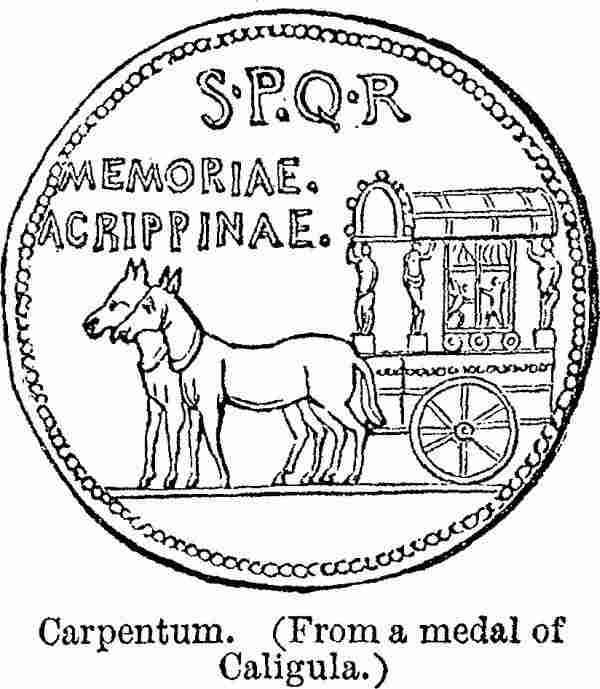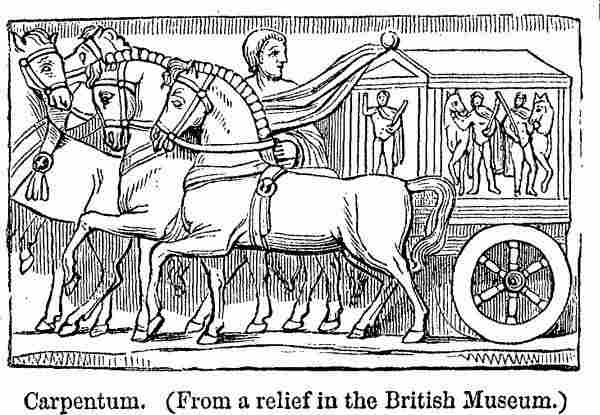.
CARPENTUM (κάρπεντον, Dio Cassius) was a two-wheeled carriage with an arched covering [CAMARA]. The use of it is mentioned in very early times at Rome, but only by privileged persons, at least within the walls. The currus arcuatus assigned by Numa to the Flamines (Liv. 1.21) is no doubt the same as the carpentum which was the travelling carriage of the elder Tarquin while still a private person (id. 34), and in which Tullia drove through the streets (id. 48). In its original form it must have been simply a covered cart, thus distinguished from the plaustrum or open cart.
The use of carriages in the city was entirely forbidden during the whole of the republic and for the first two centuries of the empire (Marquardt, 7.706; Friedländer, Sitteng. i.5 60 ff). The permission granted to L. Metellus, the Pontifex Maximus, who lost his sight B.C. 241, while rescuing the Palladium from the conflagration of the temple of Vesta, is mentioned by Pliny as absolutely unique ( “tribuit ei populus Romanus, quod nulli alii ab condito aevo, ut, quotiens in senatum iret, curru veheretur ad curiam. Magnum et sublime, sed pro oculis datum,” H. N. 7.141). It was, therefore, a considerable privilege when Roman ladies (matronae), as a reward for their patriotic generosity at the time of the fall of Veil, were allowed to drive in the pilentum (or four-wheeled carriage) at the games and public festivals, and in the carpentum on all occasions (festo profestoque, Liv. 5.25; cf. Isid. Orig. 20.12). This privilege seems to have been abridged by the Lex Oppia of B.C. 215 [SUMPTUARIAE LEGES]; and though that law was repealed twenty years afterwards, the prohibition remained in full force. It applied to all Italian towns, and was no doubt occasioned by the narrowness of ancient streets; but it was often disregarded and had to be re-enacted from time to time. The Lex Julia Municipalis, B.C. 45, forbad the use even of carts and waggons within the walls and for a mile beyond them, except at night (C. L. L. 1.206). The privileges of the Vestals, rex sacrorum, and flamines are specially reserved under this law: and those employed in the construction or demolition of buildings by public contract are excepted under certain restrictions (certeis hominibus, certeis de causeis, ib.). In other towns the law was found less easy to enforce, as we see by repeated imperial edicts (Suet. Cl. 25; Spart. Adr. 22; Capitolin. M. Ant. Phil. 23). Even empresses like Messalina and Agrippina the mother of Nero only used the carpentum in the city by special vote of the senate (D. C. 60.22, 23; Tac. Ann. 12.42). In the reign of Septimius Severus the use of state carriages was conceded to high officials, such as the praefectus praetorio, provincial governors and their legati. Alexander Severus extended the privilege to all senators. It was only in the fourth century that all restrictions on driving within the city were removed. In the country it had always been free.

Carpentum. (From a medal of Caligula.)
The carpentum of later times was a luxurious and richly ornamented carriage, used for travelling purposes and also for state occasions (Juv. 8.147 ; 9.132). We read of silken curtains (or cushions?), serica carpenta [p. 1.367](Propert. 5.8, 23). It was commonly drawn by a pair of mules (carpentum mulare, Lamprid. Heliog. 4); more rarely by oxen or horses, and sometimes by four horses as a quadriga. The form of this carriage is seen on the preceding medal. When Caligula instituted games and other solemnities in honour of his deceased mother the elder Agrippina, her carpentum went in the procession (Suet. Cal. 15); and medals, still extant, commemorated the event. Agrippina's carriage, as represented above, shows painting or carving on the panels, and the head is supported by Caryatides at the four corners.
The carriage represented in the following cut is probably also a carpentum. It is from an alto-rilievo which once adorned a sarcophagus, and is now in the British Museum. Instead of the arched camara of the last example, it has a sloping roof of low pitch, and is drawn by

Carpentum. (From a relief in the British Museum.)
four horses. Like the former, it is undoubtedly a funeral car. Mercury, in his character of ψυχοπομπὸς or conductor of souls, appears in the front, and Castor and Pollux with their horses on the side panel.
Carpenta, or covered carts, were much used by the Britons, the Gauls, the Cimbri, the Allobroges, and other northern nations (Florus, 1.18; 3.2, 3, and 10). These, together with the carts of the more common form, including baggage-waggons, appear to have been comprehended under the term carrus or carrum, which is the Celtic name with a Latin termination. The Gauls and Helvetii took a great multitude of them on their military expeditions; and, when they were encamped, arranged them in close order, so as to form lines of circumvallation (Caes. Gal. 1.24, 26).
[J.Y] [W.W]
Dictionary of Greek and Roman Antiquities
| Ancient Greece
Science, Technology , Medicine , Warfare, , Biographies , Life , Cities/Places/Maps , Arts , Literature , Philosophy ,Olympics, Mythology , History , Images Medieval Greece / Byzantine Empire Science, Technology, Arts, , Warfare , Literature, Biographies, Icons, History Modern Greece Cities, Islands, Regions, Fauna/Flora ,Biographies , History , Warfare, Science/Technology, Literature, Music , Arts , Film/Actors , Sport , Fashion --- |


